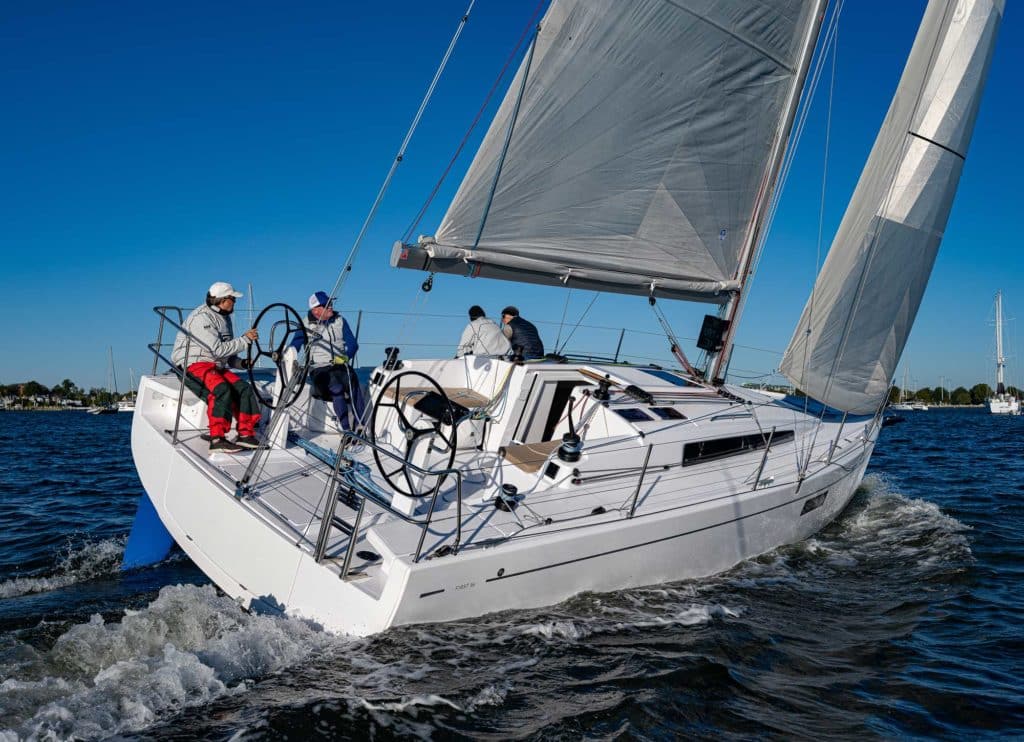
Sailing World Magazine’s annual Boat of the Year tests are conducted in Annapolis, Maryland, following the US Sailboat Show. With independent judges exhaustively inspecting the boats on land and putting them through their paces on the water, this year’s fleet of new performance-sailing boats spanned from small dinghies to high-tech bluewater catamarans. Here’s the best of the best from our 2023 Boat of the Year nominees »
The Total Package
- Beneteau First 36 2023 Boat of the Year
- Stated purpose: Shorthanded racing, club racing, coastal cruising
- Crew: Solo to six
- Praise for: Build quality, deck layout, versatility
- Est. price as sailed: $345,000
Like a runaway, the Beneteau First 36 careens across a westerly-whipped Chesapeake Bay. The boat’s big-shouldered spinnaker and mainsail are silhouetted in the early October morning light. It’s making trees on the Eastern Shore as we peg the throttle down to keep chase in a 19-foot RIB. The four crewmembers on board are having a casual conversation—like no big deal—when a cold and meaty gust fills the spinnaker. The leech flickers, and the boat surges forward onto plane. Twin rudders zipper the slick streaming out from the transom as the helmsman, hands at 10 and 2 on the carbon steering wheel, effortlessly weaves the boat across waves tops. The boat is, as the saying goes, on rails.
“Wicked,” is how senior Boat of the Year judge Chuck Allen summarizes his experience when he steps off. “That boat is going to be hard to beat.”
Three days and 10 boats later, nothing comes close to usurping the Beneteau First 36 as the obvious and unanimous Boat of the Year, a boat that has been a long time coming and overdue. It’s a boat that will serve many masters.
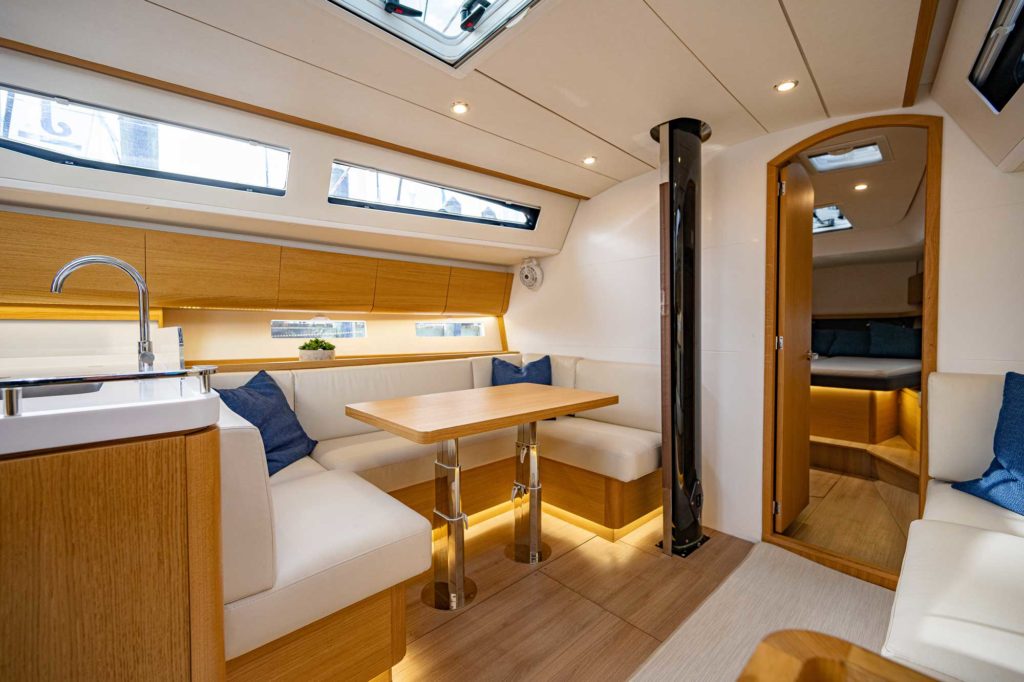
Beneteau initiated its First 36 project in 2019 by surveying a broad focus group of First “Point 7” owners and dealers about what they wanted in the marketplace, and the takeaways were: 1) Not another displacement boat—it had to plane. 2) They wanted a lounge, not a dining room. 3) They wanted their nav station back, and 4) for that, they were OK with having a smaller head.
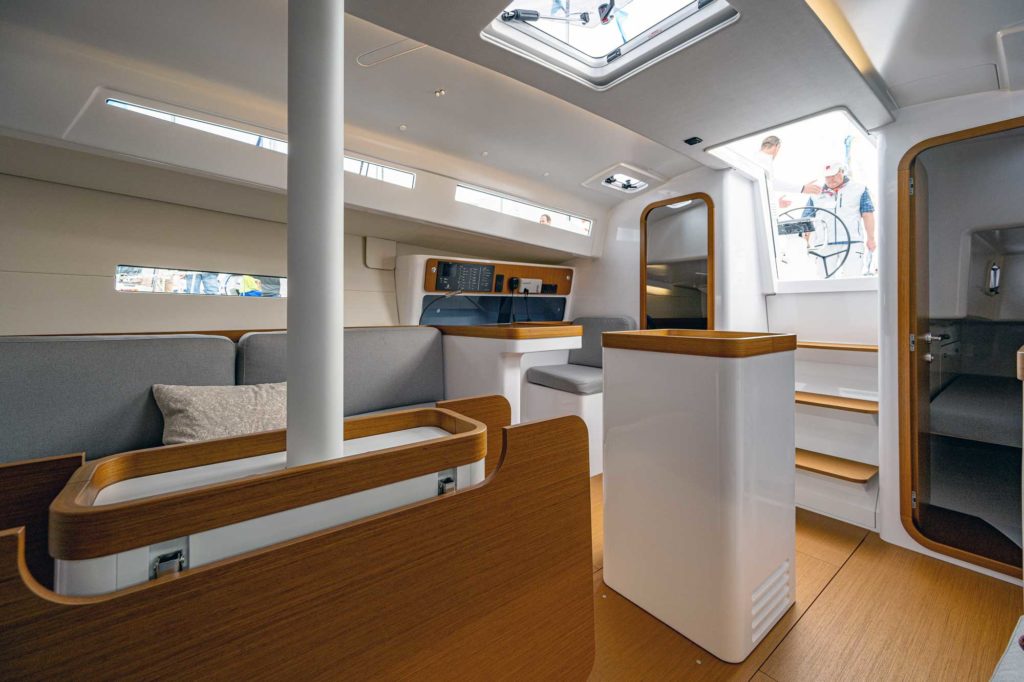
Given the boat was to meet all three of its club racing, shorthanded and cruising demands, the brain trust assembled inside and outside of Beneteau focused on No. 1—keeping it light and fast. Naval architect Samuel Manuard, the new hot talent of the IMOCA 60 and Class 40 scenes, did the hull, keel and rig. Pure Structural Engineering took care of the structure, and the weight-obsessed glass slingers at Seascape’s factory in Slovenia ensured the boat came in at not a pound more than 10,580. At that weight, of course it’s going to plane.
The entire boat is vacuum-infused with CoreCell (hull) and PVC (bulkheads) from the deck down, inside and out, and everything, except the fridge, is somehow a piece of the structure puzzle.
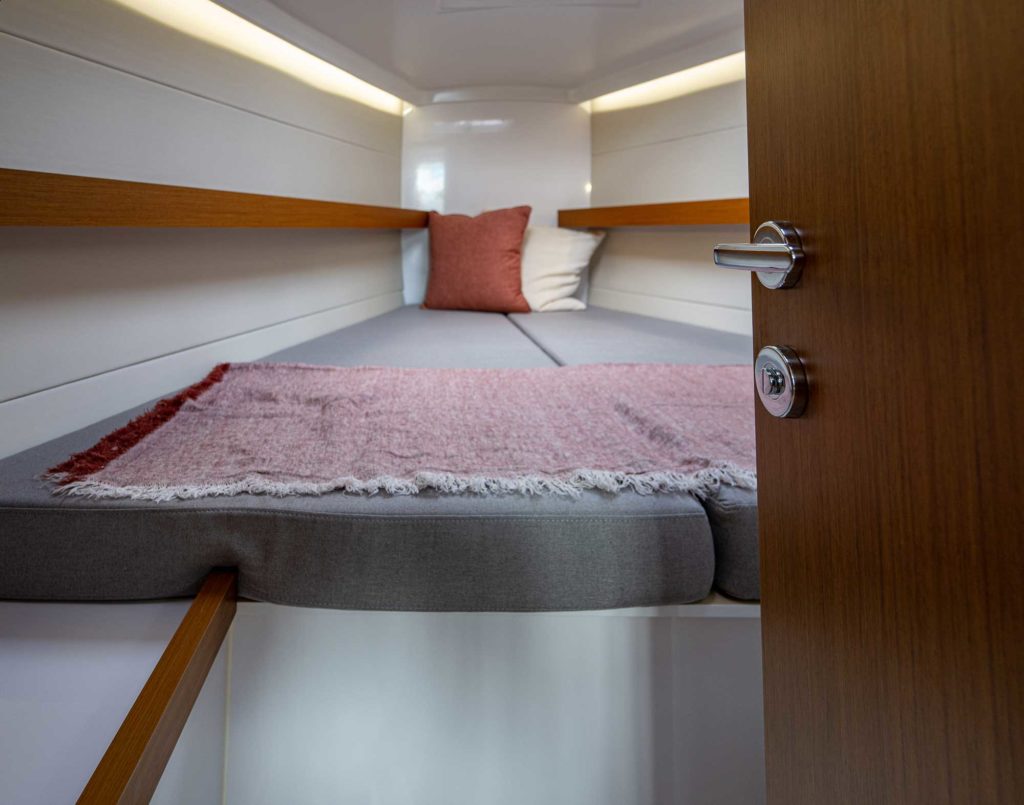
“We are saving big weight there, as furniture is also part of the structure, and all of it glued together makes the boat extremely stiff and very light,” says Beneteau’s Tit Plevnik. “What is special is how calculated it is. In mass-production building, you can’t rely on precision, but we do. The boat is built to the same standard as a pure racing boat.”
“The moment I saw it, I knew it would be good. It’s a great-looking boat at the dock and even better with the sails up.”
—Greg Stewart
Built like a race boat, the judges all agree it sure sails like one. “It’s a big 36-footer,” says veteran BOTY judge and naval architect Greg Stewart. “It’s a full-ended boat that has a hint of a scow-type bow with a lot of buoyancy forward. Looking at the numbers, what they achieved with the weight and its placement is impressive—10,000 pounds for a 36-foot waterline length is a very good number. I could tell the minute we put the spinnaker up it was a slippery boat.”
Stewart set the day’s top speed at a tick over 18 knots and says: “I remember feeling the puff hit and load the rig, and the boat just scooted off with really nice steering. It felt like a Laser when you get it in that groove and it just levitates. With the dual rudders, which are pretty long, the boat has more of a power-steering feel upwind, so it lets you do a lot of things. There’s so much control, which is a good thing because you can drive out of situations, but at the same time, it’s easy to oversteer.”
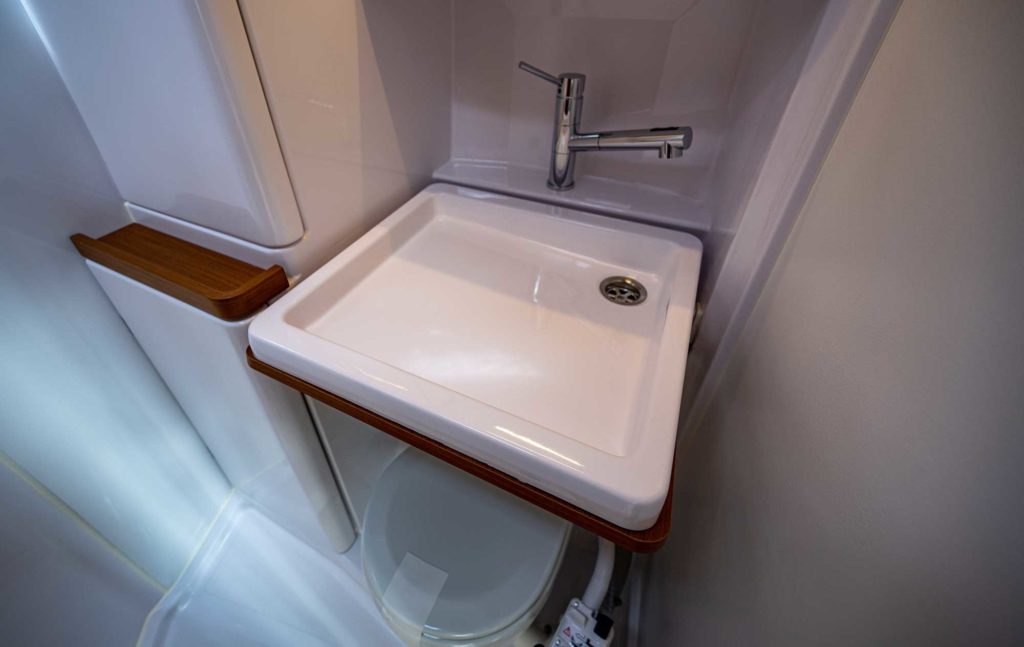
Multiple cockpit mock-ups done at different heel angles produced a workspace that the judges could find no flaw with. “It’s all legit, easy and clean in the pit,” Allen says. “With the four of us in the cockpit, we had plenty of space to move around and were never into each other.
“I was doing a lot of trimming downwind,” Allen adds. “You can feel the boat take off. It was really stable and easy to handle. The thing is light and fast, and we did push it to try and wipe it out, but it was hard to do.”
All the judges praised the clever location of the primary winches on sloped coamings, which were easier to trim from than a traditional winch-on-the-coaming setup. “They’re at the perfect height,” says judge Dave Powlison, “and with them angled like that, you don’t have to crane your neck to see the sail, and the lead is virtually override-proof.”
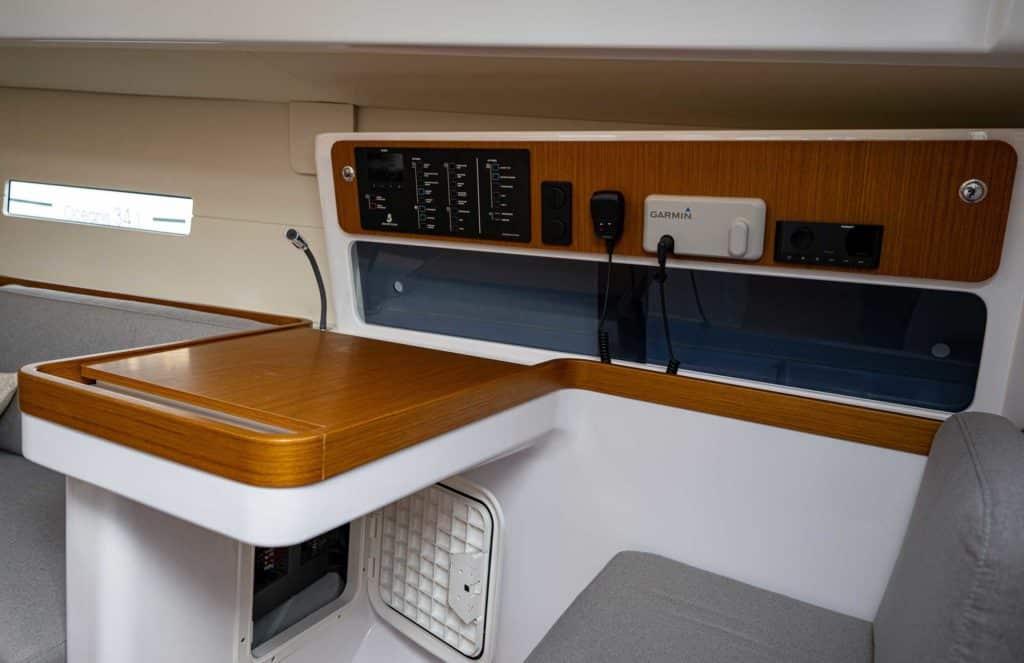
Also noteworthy is the generous space between the high carbon wheels and the cockpit walls that allow the helmsman to slide forward without having to step up and around the wheel. The jib trimmer has easy access to the three-dimensional clue adjustment systems, and for the pit, there’s plenty of clutches, redirects and cleats to keep everything sorted and tidy.
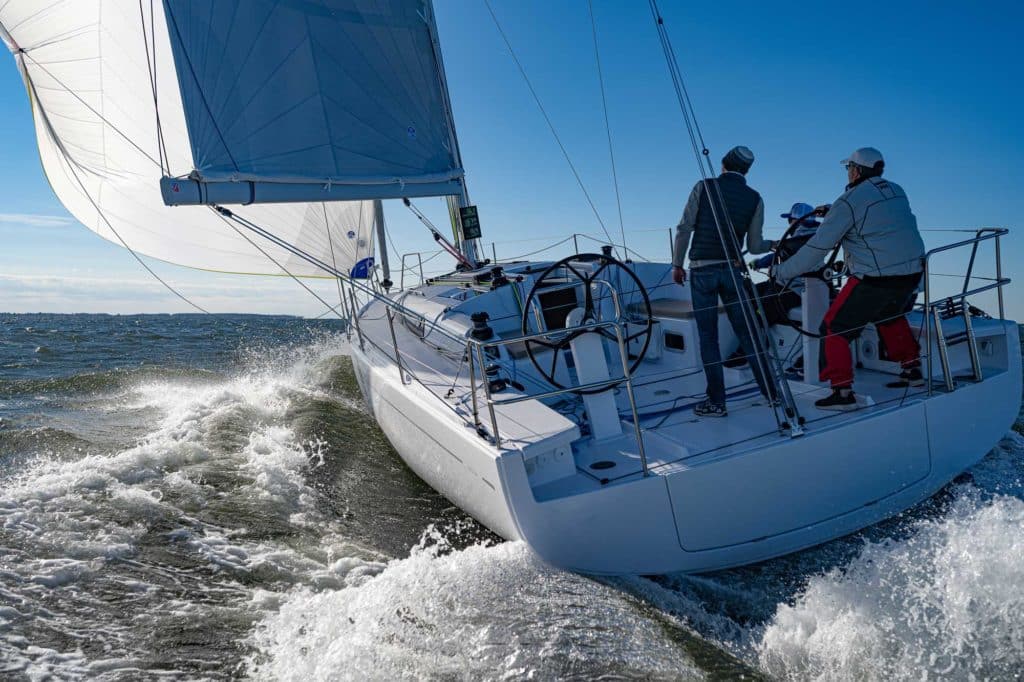
The standard spar, and that on the demo boat, is a deck-stepped Z Spars aluminum section with Dyform wire rigging that carries 860 square feet of upwind sail area, which Stewart says is considerable for the displacement of the boat. The mast is well aft, which really stretches out the J dimension and opens the foredeck for a quiver of headsails—for this, you’ll find two tack points on the foredeck. There are four halyards total: one for a masthead gennaker, a 2-to-1 for a code sail, a fractional gennaker, and a 2-to-1 staysail. Allen, a semi-retired sailmaker, put an estimate for a complete race inventory at $60,000, which would put the boat on the racecourse for roughly $400,000. (Base boat is priced at $345,000.)
When the race is done, however, how about that interior?
Step down the wide companionway steps into a space of design simplicity and efficiency, some of which makes you say, “Duh, of course.”
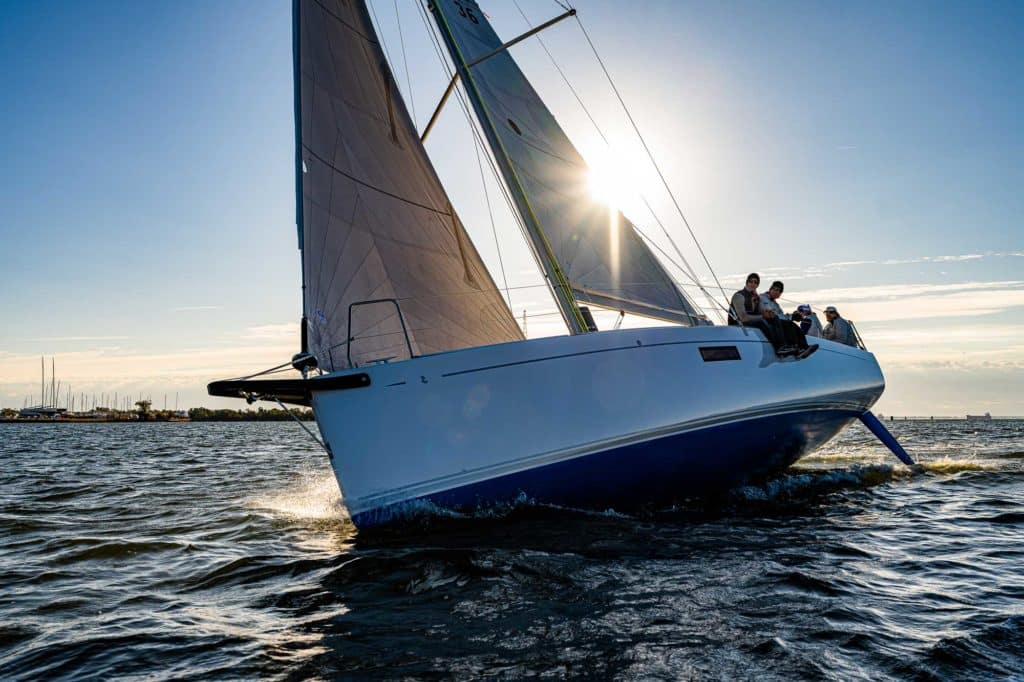
For example, there’s no traditional L-shaped galley to port or starboard. There is, however, a tall and slender fridge smack in the middle of the boat (that you connect to the galley with a removable cutting board to complete the L). Walk on either side of it to get forward, past the proper nav station, the fold-down dinette table in the middle with roomy 6-foot berths on both sides, a jetliner-size head with a stowaway sink to starboard, and then a gigantic V-berth that benefits from all that volume in the bow. Back aft, under the cockpit, are large quarter berths as well that easily cruise-convert into storage space for water toys, like kites, wings and foils, all of which takes us back to survey result No. 2. This is where the post-race party begins and ends.
With the usual supply-chain delays, compounded with the build and design team’s obsessive and calculated approach to getting the Beneteau First 36 perfect at Hull No. 1, its debut got off to a later start than hoped. But with early boats landing at eager dealers worldwide, Plevnik says the goal is 32 boats per year for the next two years. The BOTY judges assure us it’ll be worth the wait and give you plenty of time to start planning what you can and will do with it.









